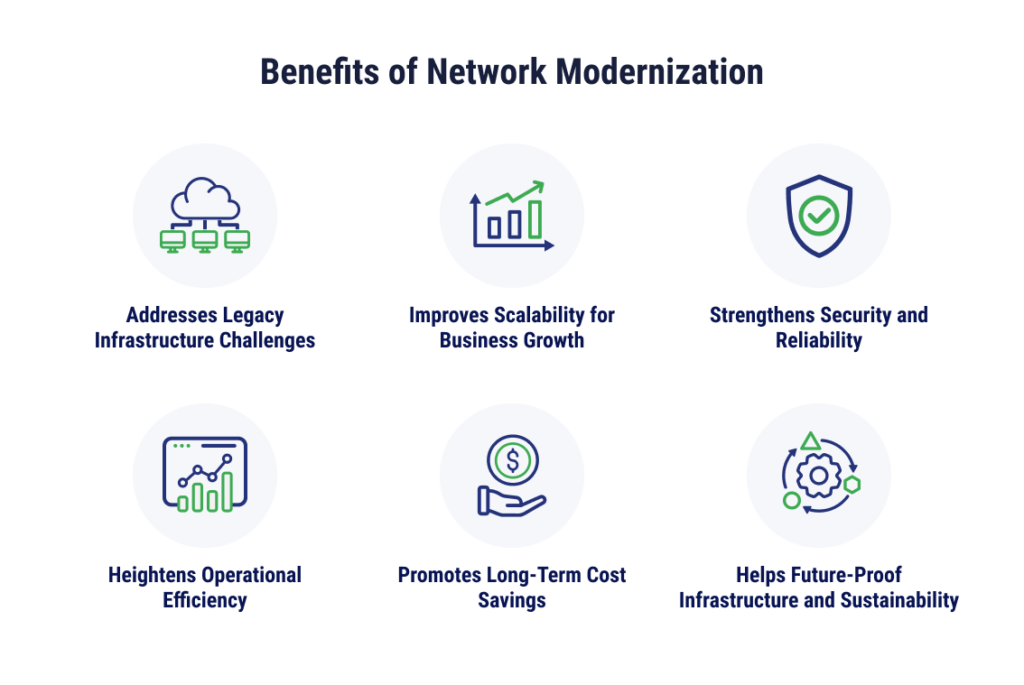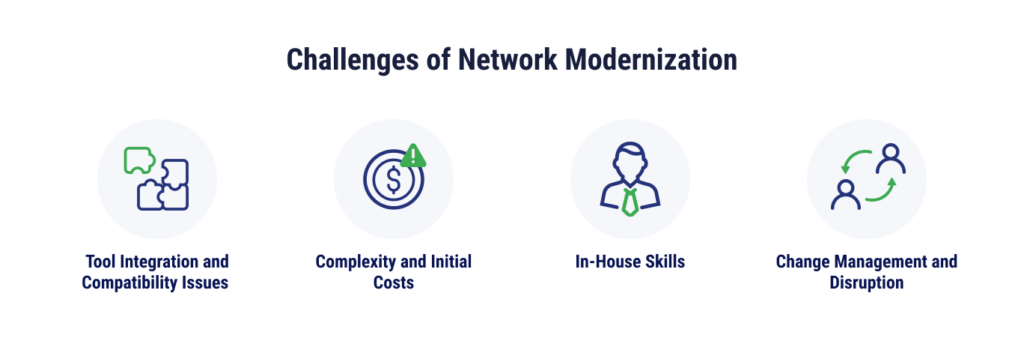March 7, 2024 | Matt Pacheco
Network Modernization for the Future: Benefits and Strategies

Agile and robust networks are necessary companions in the digital age. Network modernization, a process fueled by new technologies and optimized techniques, can unlock future business growth and help businesses make use of greater bandwidth and integration allowed by 5G and cloud connectivity. We’ll talk about the technologies, strategies, and benefits of this step in digital transformation.
What is Network Modernization?
Network modernization involves updating the current network infrastructure, generally as part of a larger IT modernization strategy. Businesses may choose to add new technologies, upgrade current ones, or perform other optimizations to usher their network infrastructure into a more innovative and interconnected realm.
Types of Popular Modern Network Technologies
Some of the most popular modern network technologies include virtualization, software-defined networking (SDN), network function virtualization (NFV), secure access service edge (SASE), 5G technology, and multicloud networking (MCN) – we’ll go into a little more detail about these later.
Why is Network Modernization Important?
In an evolving technological landscape, network infrastructure can be the key to modernizing your business or feeling trapped by your systems. Network modernization can allow you to meet your business objectives, keep up with the current state of technology, and be prepared to meet future challenges.
Key Benefits of Network Modernization
Modernizing your network comes with several benefits, including adapting your legacy infrastructure, improving your scalability, making your system more secure and reliable, boosting your efficiency, future-proofing your infrastructure, and saving you money.

1. Addresses Legacy Infrastructure Challenges
It can feel easier to maintain legacy infrastructure with little fixes here and there, but eventually, the burden of maintaining infrastructure that isn’t modernized will be something that holds your business back. By focusing on network modernization, you can identify and remedy challenges with your current legacy framework and build better paths.
2. Improves Scalability for Business Growth
James Clear, author of Atomic Habits, said: “You do not rise to the level of your goals. You fall to the level of your systems.” You can easily get penned in when your systems prevent business growth and scalability. By modernizing your network infrastructure, you improve your business’s ability to scale and grow.
3. Strengthens Security and Reliability
Older networks can also be prone to increased security and compliance issues. Network modernization can help your business resolve these issues, mitigate risks by bringing in enhanced security measures, and strengthen your infrastructure using the features inherent in modern networks.
4. Heightens Operational Efficiency
Modern network management tools offer central control, automation capabilities, and real-time insights. These features can significantly reduce the amount of time spent on administrative tasks, making your organization more operationally efficient. Monitoring and automation tools can also streamline your workflows and free up your IT resources for more pressing projects.
5. Promotes Long-Term Cost Savings
While network modernization can be a significant upfront investment, businesses can enjoy substantial long-term cost savings and see a strong return on investment. A study by NTT found that 70% of CEOs believe that their network is impeding their business growth. Improving business delivery by upgrading network infrastructure can lead to business growth, improve efficiencies, and save money over time.
6. Helps Future-Proof Infrastructure and Sustainability
Future-proofing your business stands in opposition to maintaining legacy systems. Modern network technologies, including MCN, NFV, and synchronous digital hierarchy (SDH), can allow businesses to adapt to future growth and evolving expectations at a faster rate. Many new network solutions are also more sustainable, placing priority on energy-efficient protocols and components, which is another way modernized infrastructure can result in cost savings.
Challenges of Network Modernization
New projects always bring new challenges, and launching a network modernization strategy is no different. Modernization initiatives can be complex, costly, and difficult to pull off based on the level of changes proposed and the in-house skills needed to do the job right.

Tool Integration and Compatibility Issues
While modernizing your network can boost the opportunities for integration and compatibility, businesses can also experience compatibility issues based on their current infrastructure and the tools they are using. Bringing in modern infrastructure can mean more complex workarounds are needed, or even complete upgrades of the legacy frameworks. Integrating tools can also mean increasing access points on the network, adding more vulnerabilities and security concerns. By taking a phased approach, choosing tools with open standards and APIs, and having the right team on board, businesses can reduce the risks associated with integration and compatibility issues.
Complexity and Initial Costs
Modernizing a network can be a complex project from start to finish. The process involves diverse technologies, integration tasks, and potential compatibility issues at every turn. This complexity can lead to large initial costs, but they can be worth it for the business growth and ROI that modernization allows on the other side.
In-House Skills
If your team has never taken on a modernization project, there is a good chance you won’t have the skills you need to properly plan and execute a network modernization plan. Suitable workarounds could include upskilling your current staff or leaning on outsourced talent, something that 59% of businesses are already using to fill their skill gaps.
Change Management and Disruption
Implementing a new network requires careful planning and change management to minimize disruption to ongoing operations. You’ll need to consider the potential downtime that comes with a modernization project. Businesses should also prepare to train employees to meet any changes that come with new network infrastructure.
6 Network Modernization Strategies
New and innovative strategies are available to businesses that decide to modernize their networks. They can harness cloud connectivity, software-defined networking, 5G connectivity, and more to promote scalability, flexibility, and iterative growth.
Cloud-Based Networking
Cloud modernization through cloud-based networking often entails migrating network functions and management tools to the cloud for increased flexibility, scalability, and disaster recovery abilities. Cloud connectivity decreases the need for dedicated hardware, saving costs on on-premises management. Plus, single or multicloud networking can provide centralized management and access from anywhere.
Software-Defined Networking
Software-defined networking can bring about more agility to networks by separating the control plane from the data plane. The control plane is responsible for the “how” behind data forwarding, and the data plane executes the forwarding. SDN can allow the network administrators to program the network and provision new resources quickly. New configurations and responses to traffic demands can be made in a snap. This sets SDN starkly apart from traditional networks, which need to be manually configured on each device.
Network Function Virtualization
Network function virtualization (NFV) virtualizes functions that belong to the network, including firewalls and routers. By virtualizing these functions, much like SDN, networks can have more flexibility and scalability compared to physical components.
SD-WAN
Software-defined wide area network (SD-WAN) serves as a complement to SDN and NVF by managing the data plane across branches and working with network functions such as gateways and routers. The goal of SD-WAN is to create intelligent traffic routing across different connections as a response to real-time performance and application needs.
Secure Access Service Edge (SASE)
The goal of SASE is to provide secure access, no matter the location, to applications and data. The technology employs network security functions, such as secure web gateways and firewalls, with the optimization capabilities of a wide area network (WAN).
5G Technology
5G wireless technology offers markedly lower latency and faster speeds compared to 4G. This level of connection is necessary for businesses looking to power new applications, including connected cities, autonomous vehicles, and AI-enabled tools. Modern networks are well-equipped to handle the massive data demands brought on by 5G connectivity.
Building the Right Network Modernization Plan
Businesses need to see the whole picture before they can build the right network modernization plan that will align with their goals and the current status of their infrastructure. The planning process requires specialized skills, a holistic view of the current architecture, and a clear vision of future plans. If you need some insight on where to go first with your network modernization strategy, TierPoint’s IT Advisory and Consulting services can help.
